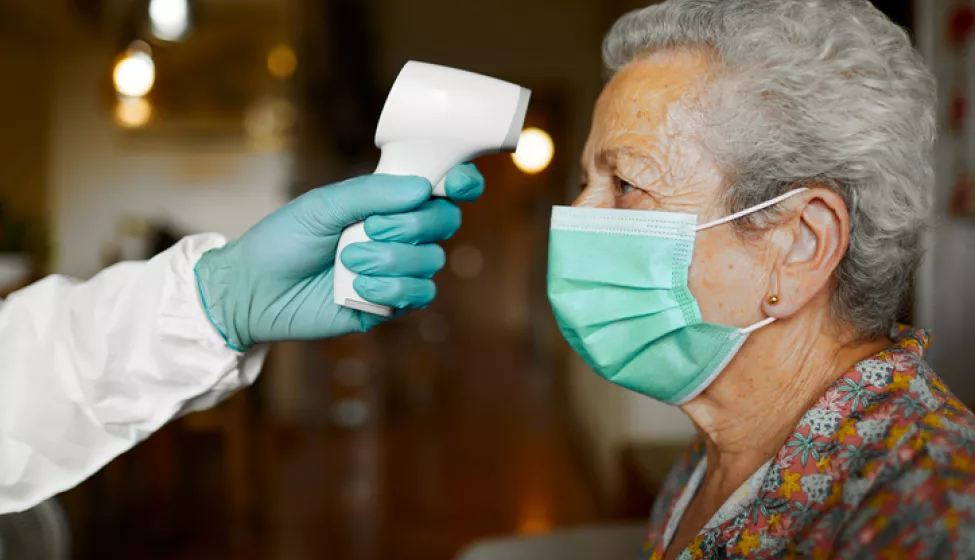July 30, 2020
Following recommendations by public health authorities, temperature checks are being incorporated into state and local strategies for reducing the spread of COVID-19 and re-opening businesses. Hand-held non-contact infrared (IR) forehead thermometers have become increasingly popular tools for measuring body temperature as part of COVID-19 related mitigation measures, due to their rapid, non-invasive, and hygienic approach to thermometry.
Yet the limitations of non-contact IR thermometers are often not properly understood by those seeking to design and implement appropriate fever-screening procedures. Important considerations related to the utility, accuracy, and reliability of these devices are often neglected, largely due to a general lack of appreciation for the science behind them and how they differ significantly from traditional thermometers.
Traditional contact thermometers used for measuring body temperature operate by thermal conduction wherein heat flows between materials in contact with one another. In contrast, IR thermometers assess thermal radiation emitted by an object by measuring radiance, a measure of the total power of electromagnetic radiation emitted from a surface.
The radiance of an object is related to its temperature and a property of the object's surface known as emissivity, a number that conveys the effectiveness with which a surface radiates energy. Thus, like traditional contact thermometers, IR thermometers give a measurement that depends on the temperature of an object being measured. However, unlike contact thermometers, the reading of an IR thermometer also depends on an object's optical surface properties. With an IR thermometer two objects at the same temperature, but with different surface properties, can produce different temperature measurements. Sweat, scarring, and even skin creams can change emissivity of skin and affect a reading with an IR thermometer.
Other factors such as distance and orientation can affect the signal detected by an IR thermometer in ways that are not necessarily intuitive to a typical user. To avoid misuse or misunderstanding, users of non-contact IR thermometers should be aware of additional limiting factors.
Distance: Holding the device too far (and sometimes too close) can lead to inaccurate readings. The prescribed distance for any non-contact IR thermometer is specified by the manufacturer. It is worth noting that this distance is often no more than around two inches.
Placement: Different parts of a person's skin, especially within the forehead region, will be at different temperatures at any given point in time. IR thermometers should be placed (aimed) according to the manufacturer's instructions, and these instructions are not universal. In some cases, proper placement may be the center of the forehead, and in others it may be over the temporal artery.
Surface Properties: The presence of sweat, dust, scar tissue, or topical substances, including makeup, may all affect skin temperature measured with a non-contact IR thermometer. It is recommended to follow manufacturer's recommendations in this area as well.
Accuracy: Every IR thermometer has a specified accuracy. This value, commonly around 0.5°F, is dictated primarily by the electronic and optical components and by the factory-performed calibration procedure.
Environmental Range: An IR thermometer may be affected by the temperature and humidity of the surrounding environment. Every IR thermometer has a limited range of environmental conditions, as specified by the manufacturer, in which accurate readings can be assured. IR thermometers must also be permitted to thermally equilibrate with their surroundings for a period of time usually between 10 and 30 minutes, depending on the manufacturer, as abrupt changes in air temperature will lead to inaccuracies.
A user's awareness and consideration of these limitations can help mitigate or offset a loss of accuracy, reliability, or the potential for improper interpretation of the results. To this end, business owners or employers overseeing measurements with these devices, as well as the individuals performing the actual measurements, must carefully consider the protocols and procedures in place for every given usage scenario, and adhere to a consistent approach, in accord with a thermometer's operating instructions.
How Exponent Can Help
Exponent's multidisciplinary team of consumer electronics and medical device specialists can help clients work within the limitations of IR thermometry to take full advantage of its benefits. Exponent can assist clients in evaluating IR thermometry technologies that may be newly available or under development. With better understanding of the science behind the technology, state and local governments as well as business big and small can ensure accurate use of IR thermometers in effective screening programs.



